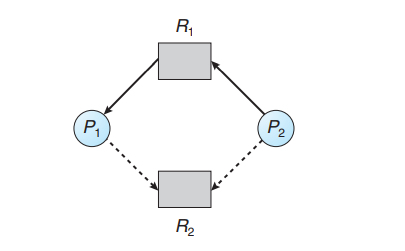An alternative method for avoiding deadlocks is to require additional information about how resources are to be requested.
For example, in a system with one tape drive and one printer, the system might need to know that process P will request first the tape drive and then the printer before releasing both resources, whereas process Q will request first the printer and then the tape drive. With this knowledge of the complete sequence of requests and releases for each process, the system can decide for each request whether or not the process should wait in order to avoid a possible future deadlock.
Each request requires that in making this decision the system consider the resources currently available, the resources currently allocated to each process, and the future requests and releases of each process
Two deadlock-avoidance algorithms
A state is safe if the system can allocate resources to each process (up to its maximum) in some order and still avoid a deadlock. More formally, a system is in a safe state only if there exists a safe sequence.
A sequence of processes is a safe sequence for the current allocation state if, for each Pi , the resource requests that Pi can still make can be satisfied by the currently available resources plus the resources held by all Pj , with j < i. In this situation, if the resources that Pi needs are not immediately available, then Pi can wait until all Pj have finished.
When they have finished, Pi can obtain all of its needed resources, complete its designated task, return its allocated resources, and terminate. When Pi terminates, Pi+1 can obtain its needed resources, and so on. If no such sequence exists, then the system state is said to be unsafe
Resource-Allocation-Graph Algorithm
A claim edge Pi→ Rj indicates that process Pi may request resource Rj at some time in the future. This edge resembles a request edge in direction but is represented in the graph by a dashed line. When process Pi requests resource Rj , the claim edge Pi → Rj is converted to a request edge. Similarly, when a resource Rj is released by Pi, the assignment edge Rj → Pi is reconverted to a claim edge Pi → Rj .

Several data structures must be maintained to implement the banker’s algorithm. These data structures encode the state of the resource-allocation system. We need the following data structures, where n is the number of processes in the system and m is the number of resource types:
Available. A vector of length m indicates the number of available resources of each type. If Available[j] equals k, then k instances of resource type Rj are available
Max. An n × m matrix defines the maximum demand of each process. If Max[i][j] equals k, then process Pi may request at most k instances of resource type Rj
Allocation. An n × m matrix defines the number of resources of each type currently allocated to each process. If Allocation[i][j] equals k, then process Pi is currently allocated k instances of resource type Rj .
Need. An n × m matrix indicates the remaining resource need of each process. If Need[i][j] equals k, then process Pi may need k more instances of resource type Rj to complete its task. Note that Need[i][j] equals Max[i][j] − Allocation[i][j].
Safety Algorithm
This algorithm can be described as follows:
Let Work and Finish be vectors of length m and n, respectively. Initialize Work = Available and Finish[i] = false for i = 0, 1, …, n − 1.
- Find an index i such that both
- Finish[i] == false
- Needi ≤ Work
If no such i exists, go to step 4
Work = Work + Allocationi Finish[i] = true Go to step 2
If Finish[i] == true for all i, then the system is in a safe state
Resource-Request Algorithm
Let Requesti be the request vector for process Pi . If Requesti [j] == k, then process Pi wants k instances of resource type Rj . When a request for resources is made by process Pi , the following actions are taken:
- If Requesti ≤ Needi , go to step 2. Otherwise, raise an error condition, since the process has exceeded its maximum claim
- If Requesti ≤ Available, go to step 3. Otherwise, Pi must wait, since the resources are not available.
- Have the system pretend to have allocated the requested resources to process Pi by modifying the state as follows:
Available = Available–Requesti ;
Allocationi = Allocationi + Requesti ;
Needi = Needi –Requesti ;
If the resulting resource-allocation state is safe, the transaction is completed, and process Pi is allocated its resources. However, if the new state is unsafe, then Pi must wait for Requesti , and the old resource-allocation state is restored
